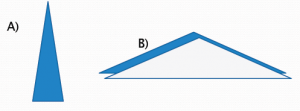Based on the article posted by KPMG on, “People and Change,” the third-largest accounting firm describes their wide range of services concerning organizational structure, optimization, human resources management and change management for various companies. These services relate to concepts we have learnt in class. For example, KPMG is considered a big firm with an organizational structure depicted through the diagram below:
Out of these two structures, KPMG is diagram (B) because it is a “Big Firm;” therefore, the company will be able to hold more people and positions at each level. Ultimately, this means that an individual would rather work in (B) compared to (A) because it’s easier to advance, holds more opportunities, and there are more people for you to outshine. Organizational structure (A) includes small or boutique firms where there are very few people at each level and less opportunities.
Thus, KPMG’s organizational structure optimization team has the ability to assist companies in solving tactical issues. Head of Management Consulting, Howard Polinski, says that there are “seven tests for organizational structures” using KPMG’s internal methodology. These seven groups of services include: organizational structure diagnostics, development of a corporate centre model, development of a compensation system, change management, corporate culture assessment, and communications management.

